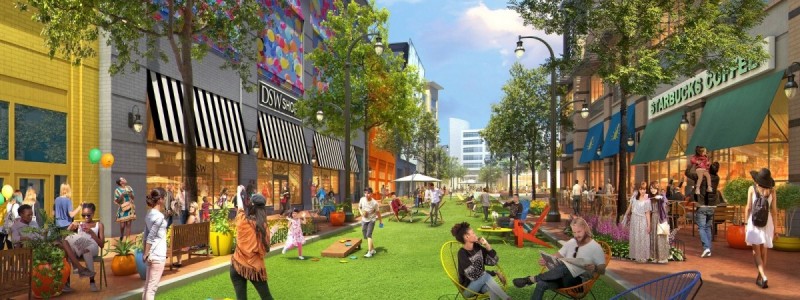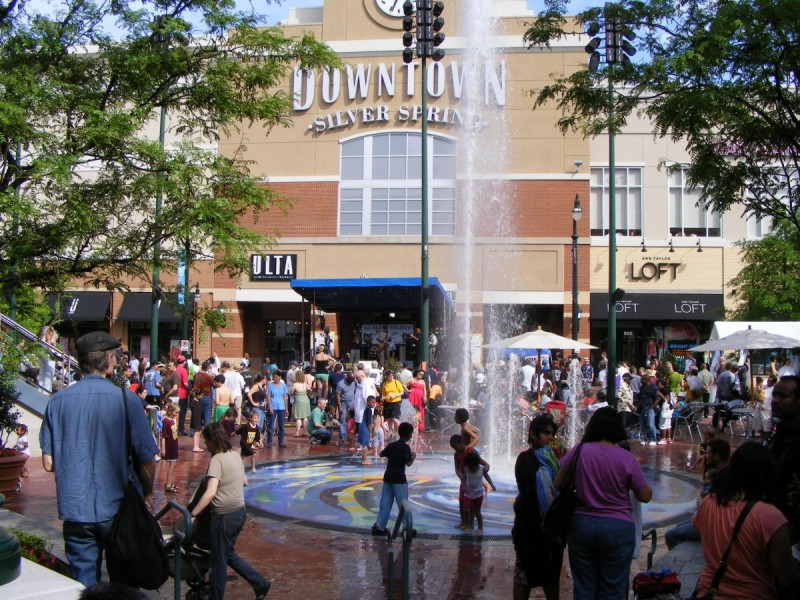After 15 years, Downtown Silver Spring is getting a big update

The plaza on Ellsworth Drive will be totally rebuilt, including the removal of the popular "splash pad." Image by Foulger-Pratt used with permission.
A lot of things happened in the summer and the fall of 2004, when I was starting my senior year of high school. What sticks out most is the night in August I stood with three of my closest friends at the entrance of a new parking garage in downtown Silver Spring, yet to open, daring each other to go in.
The concrete was still clean and smooth as we strode up the big ramp, our voices bouncing around seven empty floors as we ascended. At the top of the garage, we walked out onto the sun setting over the then-brand new development called Downtown Silver Spring: a 20-screen movie theatre, a Whole Foods, a hotel, a brightly-colored tile plaza with a fountain.
It felt especially surreal for the 16-year-old me, having lived in little-D downtown Silver Spring, land of boarded-up buildings and empty storefronts, until 5th grade. Now there were signs saying “Silver SprUng” (as in, Silver Spring had “sprung”) and even a TV commercial.
At the moment, the only sound came from some whirring generators in a corner by the elevator that would take us back down, and my friend Sean looked over his shoulder as he slid over, unzipped his pants, and took a piss. We had christened this place and made it ours.
Fast forward 15 years
A few weeks ago, at 31, I sat in a crowd of about 50 people in the Silver Spring Civic Building listening to Bryant Foulger of Foulger-Pratt, the developer who built Downtown Silver Spring, explain how he was going to renovate the place. Foulger-Pratt and property manager Peterson Companies will bring in new tenants like wine bar Locavino and bowling alley The Eleanor; commissioned murals by DC creative agency No Kings Collective, and will permanently close part of a parking lot and the development’s spine, Ellsworth Drive, to cars.
Ellsworth Drive could get covered in artificial turf. Image by Foulger-Pratt used with permission.
“The nature of retail is changing. It’s much more focused on experience,” said Foulger. “We’re also focused on physical plant. Things are wearing out…so we’re thinking about ways to refresh it.”
Fifteen years may not seem like a long time. But Foulger noted that when Downtown Silver Spring opened, in phases starting in 2000 (Ellsworth Drive opened in 2004) and concluding in 2013, the project was kind of experimental. Just a few years earlier, most of downtown was nearly scrapped and replaced with a Mall of America clone. Silver Spring was still struggling after decades of middle-class flight, and some local shopkeepers worried the new development would steal business from them.
“There was a lot of uncertainty, a lot of things we didn’t know would work,” he said. “But as this opened and all of you started coming here, we saw what worked and we saw things we wanted to change.”
Downtown Silver Spring's retail has changed with the times, like Borders, which closed in 2011. Image by the author.
When it opened, DTSS (as the kids call it) had the kind of places you’d go to once in a while, for big purchases: sit-down, white-tablecloth restaurants; high-end furniture and home design stores like Storehouse and Marimekko; and a few basic needs that neighbors had asked for, like a hardware store. The development was marketed as “A Good Old-Fashioned Sensory Overload,” but one resident described it as a cross between Bethesda and Adams Morgan “with more culture.”
Instead, the place attracted teens and families who weren’t big spenders, but did come to hang out every weekend. The furniture stores were first to go, and Silver Spring may have even kept Borders Books & Music on life support before it finally folded. Taking their place were stores that sold cheaper things you’d buy more often, like fast-casual restaurants and “fast fashion” retailers like H&M. Ellsworth Drive closed to cars some weekends, then every weekend, and eventually all the time.
Over time, DTSS evolved into not just a shopping center, but the heart of a diverse community. Montgomery County opened the Silver Spring Civic Building in 2010 and the Silver Spring Library in 2015 adjacent to the development, providing access to public services and a platform for gatherings, from the annual Ethiopian Festival to protests. Today, the development looks prescient: Silver Spring is now one of Montgomery County’s strongest real estate markets, and you can see little bits of DTSS across Maryland and Virginia, and even in DC neighborhoods like Columbia Heights and the Wharf.
More changes, and more questions
Just like me, generations of kids have now grown up with this place, as there’s a lot of free or cheap stuff to do. We used to kill time in Borders and sneak into R-rated movies; today, little kids might run around in the splash pad, or take up skateboarding, which Silver Spring has been a hub for since the 1990s.
Those last two things may be going away. Foulger’s plans include replacing the splash pad with an “interesting, iconic” art piece and water feature, and the area surrounding it will get large, movable woodblocks which can work as seating or be pushed together to form a stage. Ellsworth Drive will become a lawn for most of its length.
After 15 years, the trees on Ellsworth Drive have gotten really big! Image by the author.
“This will be ironic if you’ve been here a while, but we’re going to put down artificial turf,” said Foulger, referring to “The Turf,” the popular temporary hangout that used to sit where Veterans Plaza is now. Unlike “The Turf,” which was basically empty green space, this turf will have movable chairs and games like cornhole.
People had a lot to say about this. “Is this going to create a noisy atmosphere? Silver Spring is very noisy,” said one man. “What’s wrong with pavement?” asked a woman. Another woman got up and said, “You have a lot of homeless and mentally ill, and they’re going to sleep on that furniture.”
But the biggest questions were about whether the new turf will disrupt the activities that currently happen on Ellsworth Drive, like the weekly farmers’ market (produce trucks can drive on turf, Foulger said). Parents of young children asked where their kids would play without the splash pad.
Kids play in the splash pad in 2009. Image by the author.
“There are lots of ways to engage kids,” said Foulger. “We engaged them with water, we’ll engage them with something different, and in a couple of years we’ll do something else.”
Skaters are likely to get pushed out under this plan, just as they were from Veterans Plaza shortly after it opened, and back in the 1990s from East of Maui, a skate park once located on Ellsworth Drive. People have been skating here for over 20 years, and while people mentioned that they like watching skateboarders, there wasn’t an answer about where they’ll go.
Urban places are always evolving
As director of the Silver Spring Regional Services Center—a fancy term for a county position that is unofficially called the “Mayor of Silver Spring”—for over a decade, Reemberto Rodriguez and has seen many of the changes in Downtown Silver Spring firsthand. Even as neighbors fretted over the future of Ellsworth Drive, he was sanguine about the possibilities.
A crowd forms to watch skateboarders on Ellsworth Drive in 2008. Image by the author.
“No urban space can stay static for a decade,” he told the crowd. “If it does, it is economically dead. It is proven.”
This meeting, and the 15th anniversary of my friend peeing on a parking garage, has made me reflect on Downtown Silver Spring and what it meant to my life. I spent my late teens goofing off here, and now I work across the street and until recently I lived a few blocks away. I have a lot of memories in this place. I’ve seen this place evolve, and this place has seen me grow into an adult, which is a weird thing to say about something that’s basically an outdoor shopping mall. But it shows that the DTSS experiment worked: it means a lot to a lot of people, and naturally people are going to feel protective of it.
Some of the changes in Downtown Silver Spring are already underway, like a multi-colored new paint job and murals. Bigger changes, like removing the fountain and laying turf on Ellsworth Drive, require approval from the Montgomery County Planning Board. Before the developers submit those plans for review, they’ve created a website with more info and are holding a community meeting to discuss them on Thursday, October 10 from 7 to 8 pm at the Courtyard Marriott, located at 8506 Fenton Street.
